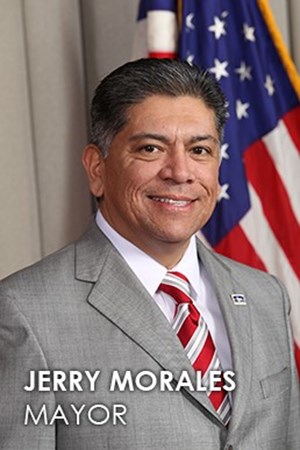In America's oil boomtown, they don't talk of busts anymore
HOUSTON (Bloomberg) -- Jerry Morales, mayor of Midland, Texas, the unofficial capital of the Permian basin, has a chance to break from the boom and bust pattern.
In the Permian, "we don’t say boom anymore," according to Morales,. "We’re very sustainable. The boom-and-bust era is over."
What a difference a year can make. In 2018, Morales sat in the Mulberry Cafe in Midland and talked of a local economy that was "on fire" and out of control because of the oil boom. A year later, sitting in the same cafe, his message is decidedly different.
Midland is using a $100 million bond to fix overused roads, and accessing a $180 million regional fund from a new coalition of 20 drillers for other advances, he said. A $50 million water tower has been approved to serve expanding neighborhoods, and a $3 million animal adoption center is in the works for pets left homeless by apartment-dwelling oil workers.
Meanwhile, four drillers led by Chevron Corp. have funded a new childcare facility that opened last week.
"I don’t want Midland to be known as a big mancamp," Morales said. "We are having to think outside the box and truly be urban planners, creating a city and an environment that’s inviting for everyone."
The Permian rose from the dead with the advent of fracing a decade ago to become a market beast, producing about a third of U.S. oil as it grew to become one of the world’s most prolific oilfields.
In the process, though, local resources were stretched beyond their limits. Now, Morales and others say the region may be settling into adulthood. Employers still struggle to fill jobs in competition with the oilfields, roads are jammed, schools overflow and home prices are sky-high. But local leaders say they have plans and resources set to secure a long-term future.
The changes are coming as oil traders and shale executives believe U.S. crude exports -- driven by success in the Permian -- will reach 5 MMbopd by late 2020, up about 60% from last year’s average. If that target is hit, America will be exporting, on a gross basis, more crude than any country in OPEC, except Saudi Arabia.
Even so, the drilling rig count in the Permian sits at almost the same level as a year ago, at 460, according to Baker Hughes, a GE company. And the number of fracing crews working to complete drilled wells is down 8 percent, according to Primary Vision Inc., a Houston-based data firm.
Schlumberger Ltd. and Halliburton Co., the world’s biggest oilfield service companies, have estimated explorers could cut spending in the U.S. shale patch by roughly double digits this year compared to last.
Controlled expansion
Analysts say the breakneck pace of drilling and no-holds-barred development that upended the Permian economy for much of the past decade is now mellowing as entrepreneurial explorers make way for corporate managers. Where wildcatters once ruled, Exxon and Chevron, America’s two biggest energy companies, are quickly becoming the faces of that controlled expansion.
Indeed, Chevron is now in a rare-in-the-industry bidding war with Occidental Petroleum Corp. to acquire Anadarko Petroleum Corp. and expand its influence in the region.
Although there’s probably still a lot of oil to be found, explorers finally have a good handle on where the richest zones lie, meaning there’s no longer a scramble to strike the next big discovery.
"We’re a well-established oilfield; we’re not an adolescent anymore," said Wesley Burnett, who runs the economic development program for Odessa, 20 mi southwest of Midland. "There’s definitely been some realization of: ‘Man, we’ve got to do some things differently in order to get to that next level.’"
Tracee Bentley, a former aid to Colorado Gov. John Hickenlooper, is the CEO of the 20-driller Permian Strategic Partnership, launched in November to help local communities deal with the added stress they bring. Among its members are Chevron Corp., Anadarko Petroleum Corp., ConocoPhillips and Apache Corp.
Strategic partnership
The partnership being forged between the oil companies and the local communities is unlike anything achieved elsewhere, Bentley said.
"We’re literally creating it as we go, which is fun and frightening all at the same time," she said in an interview. "The amount of work can be daunting if you look at the basin as a whole. We really want the Permian to be a place that families call home."
Susie Hitchcock-Hall, for one, is impressed by the changes so far.
Hitchcock-Hall, a longtime Midland-based candy maker dubbed the "Willy Wonka of West Texas," owns a candy factory in Midland that can safely hold two busloads of children at a time, she said. A giant tin dish on one wall was once used to enter the Guinness World Records for the biggest piece of toffee ever made. It weighed 2,940 pounds.
The Permian of today has a different feel to it from the roller coaster rides of the past, she said, and she’s impressed the oil companies are chipping in. "They’ve pulled the big dogs in," Hitchcock-Hall said. They have the "wherewithal, and they’re smart."
Still, even as leaders like Morales hesitate to describe the region’s state as being a "boom," there are boomtown reminders everywhere.
At Opal’s Table in downtown Midland, for instance, every seat was taken on a recent Wednesday night as diners noshed on $36 Seared Ahi Tuna Steak and sipped $14 Liquid Gold cocktails. Meanwhile, just outside, city of Midland-owned vehicles tooled around town with a sign on their door advertising "now hiring."
The city’s unemployment rate was at 2.2% in February, compared with 3.8% nationally, according to the U.S. Bureau of Labor Statistics.
"We’re not going to make anybody move here," said Mitch Jones, who manages the Permian Basin fracing business for BJ Services Inc., one of the biggest providers of completion services in the Permian. "Now if they choose to, well great. It definitely helps if they are local."



